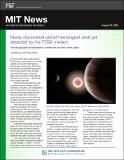| dc.description.abstract | More than 80 percent of confirmed exoplanets have orbits shorter than 50 days. Astronomers are starting to get a general picture of these planets’ formation, evolution, and composition. But the picture is much fuzzier for planets with longer orbital periods. Far-out worlds, with months- to years-long orbits, are more difficult to detect, and their properties have therefore been trickier to discern.
Now, the list of long-period planets has gained two entries. Astronomers at MIT, the University of New Mexico, and elsewhere have discovered a rare system containing two long-period planets orbiting TOI-4600, a nearby star that is 815 light years from Earth.
The discovery was made using data from NASA’s Transiting Exoplanet Survey Satellite, or TESS — an MIT-led mission that monitors the nearest stars for signs of exoplanets. The new, farther planet has the longest period that TESS has detected to date. | en_US |
